Bosch 1005VSR, 1004VSR User Manual
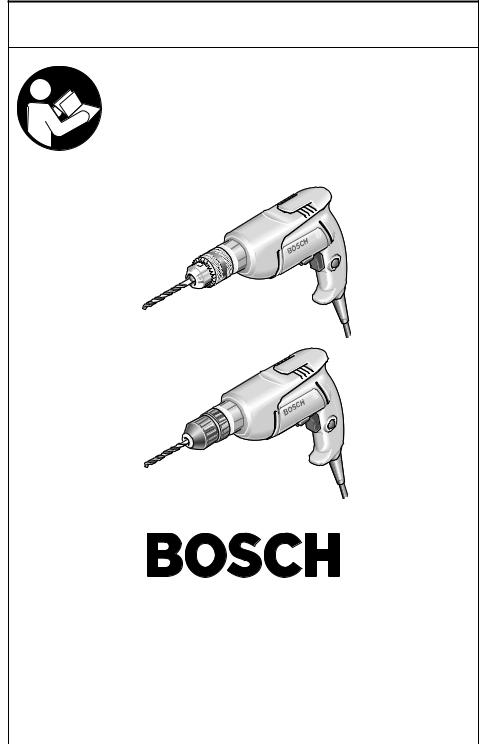
IMPORTANT: |
IMPORTANT : |
IMPORTANTE: |
Read Before Using |
Lire avant usage |
Leer antes de usar |
Operating/Safety Instructions Consignes de fonctionnement/sécurité
Instrucciones de funcionamiento y seguridad
1004VSR
1005VSR
|
Call Toll Free |
Pour renseignement des |
Llame gratis para |
|
for Consumer Information |
consommateurs et centres |
obtener información |
||
|
& Service Locations |
de service, appelez au |
para el consumidor y |
|
|
|
numéro gratuit : |
ubicaciones de servicio |
|
|
|
|
||
|
1-877-BOSCH99 (1-877-267-2499) www.boschtools.com |
|
||
|
|
|
|
|
For English |
Parlez-vous français? |
¿Habla español? |
||
See page 2 |
Voir page 11 |
Ver página 20 |
||

General Safety Rules
! WARNING Read all instructions. Failure to follow all instructions listed below may result in electric shock, fire and/or serious injury. The term “power tool” in
all of the warnings listed below refers to your mains-operated (corded) power tool or batteryoperated (cordless) power tool.
SAVE THESE INSTRUCTIONS
Work area safety
Keep work area clean and well lit.
Cluttered or dark areas invite accidents.
Do not operate power tools in explosive atmospheres, such as in the presence of flammable liquids, gases or dust. Power tools create sparks which may ignite the dust or fumes.
Keep children and bystanders away while operating a power tool. Distractions can cause you to lose control.
Electrical safety
Power tool plugs must match the outlet. Never modify the plug in any way. Do not use any adapter plugs with earthed (grounded) power tools. Unmodified plugs and matching outlets will reduce risk of electric shock.
Avoid body contact with earthed or grounded surfaces such as pipes, radiators, ranges and refrigerators. There is an increased risk of electric shock if your body is earthed or grounded.
Do not expose power tools to rain or wet conditions. Water entering a power tool will increase the risk of electric shock.
Do not abuse the cord. Never use the cord for carrying, pulling or unplugging the power tool. Keep cord away from heat, oil, sharp edges or moving parts. Damaged or entangled cords increase the risk of electric shock.
When operating a power tool outdoors, use an extension cord suitable for outdoor use. Use of a cord suitable for outdoor use reduces the risk of electric shock.
Do not use AC only rated tools with a DC power supply. While the tool may appear to work, the electrical components of the AC rated tool are likely to fail and create a hazard to the operator.
If operating the power tool in damp locations is unavoidable a Ground Fault Circuit Interrupter (GFCI) must be used to supply the power to your tool. GFCI and personal protection devices like electrician’s rubber gloves and footwear will further enhance your personal safety.
Personal safety
Stay alert, watch what you are doing and use common sense when operating a power tool. Do not use a power tool while you are tired or under the influence of drugs, alcohol or medication. A moment of inattention while operating power tools may result in serious personal injury.
Use safety equipment. Always wear eye protection. Safety equipment such as dust mask, non-skid safety shoes, hard hat, or hearing protection used for appropriate conditions will reduce personal injuries.
Avoid accidental starting. Ensure the switch is in the off-position before plugging in. Carrying power tools with your finger on the switch or plugging in power tools that have the switch on invites accidents.
Remove any adjusting key or wrench before turning the power tool on. A wrench or a key left attached to a rotating part of the power tool may result in personal injury.
Do not overreach. Keep proper footing and balance at all times. This enables better control of the power tool in unexpected situations.
Dress properly. Do not wear loose clothing or jewelry. Keep your hair, clothing and gloves away from moving parts. Loose clothes, jewelry or long hair can be caught in moving parts.
If devices are provided for the connection of dust extraction and collection facilities, ensure these are connected and properly used. Use of these devices can reduce dustrelated hazards.
-2-

Keep handles dry, clean and free from oil and grease. Slippery hands cannot safely control the power tool.
Power tool use and care
Do not force the power tool. Use the correct power tool for your application.
The correct power tool will do the job better and safer at the rate for which it was designed.
Do not use the power tool if the switch does not turn it on and off. Any power tool that cannot be controlled with the switch is dangerous and must be repaired.
Disconnect the plug from the power source and/or the battery pack from the power tool before making any adjustments, changing accessories, or storing power tools. Such preventive safety measures reduce the risk of starting the power tool accidentally.
Store idle power tools out of the reach of children and do not allow persons unfamiliar with the power tool or these instructions to operate the power tool.
Power tools are dangerous in the hands of untrained users.
Maintain power tools. Check for misalignment or binding of moving parts, breakage of parts and any other condition that may affect the power tools operation. If damaged, have the power tool repaired before use. Many accidents are caused by poorly maintained power tools.
Keep cutting tools sharp and clean.
Properly maintained cutting tools with sharp
cutting edges are less likely to bind and are easier to control.
Use the power tool, accessories and tool bits etc., in accordance with these instructions and in the manner intended for the particular type of power tool, taking into account the working conditions and the work to be performed.
Use of the power tool for operations different from those intended could result in a hazardous situation.
Use clamps or other practical way to secure and support the workpiece to a stable platform. Holding the work by hand or against your body is unstable and may lead to loss of control.
Empty dust container frequently, especially when sanding wood with polyurethane, varnish, shellac or similarly coated surface. Fine particles of sanding dust may self ignite and cause fire.
Service
Have your power tool serviced by a qualified repair person using only identical replacement parts. This will ensure that the safety of the power tool is maintained.
Develop a periodic maintenance schedule for your tool. When cleaning a tool be careful not to disassemble any portion of the tool since internal wires may be misplaced or pinched or safety guard return springs may be improperly mounted. Certain cleaning agents such as gasoline, carbon tetrachloride, ammonia, etc. may damage plastic parts.
SAVE THESE INSTRUCTIONS
Safety Rules for Drills
Hold tool by insulated gripping surfaces when performing an operation where the cutting tools may contact hidden wiring or its own cord. Contact with a “live” wire will make exposed metal parts of the tool “live” and shock the operator. Do not drill, fasten or break into existing walls or other blind areas where electrical wiring may exist. If this situation is unavoidable, disconnect all fuses or circuit breakers feeding this worksite.
Always wear safety goggles or eye protection when using this tool. Use a dust mask or respirator for applications which generate dust.
Secure the material being drilled. Never hold it in your hand or across legs.
Unstable support can cause the drill bit to bind causing loss of control and injury.
Never leave the trigger locked "ON". Before plugging the tool in, check that the
-3-

trigger lock is "OFF". Accidental start-ups could cause injury.
Position the cord clear of rotating bit. Do not wrap the cord around your arm or wrist. If you lose control and have the cord wrapped around your arm or wrist it may entrap you and cause injury.
Position yourself to avoid being caught between the tool or side handle and walls or posts. Should the bit become bound or jammed in the work, the reaction torque of the tool could crush your hand or leg.
If the bit becomes bound in the workpiece, release the trigger immediately, reverse the direction of rotation and slowly squeeze the trigger to back out the bit. Be ready for a strong reaction torque. The drill body will tend to twist in the opposite direction as the drill bit is rotating.
Do not grasp the tool or place your hands too close to the spinning chuck or drill bit. Your hand may be lacerated.
Do not use the switch "Lock-ON" feature in situations where drill bit binding is likely. (For example: just before the bit is ready to break through the material, anytime when using a "Hole Saw", auger bits........ etc.) When the bit binds, the drill's body will twist or kick-back in opposite direction and the release of the trigger "LockON" may be difficult.
Be aware of the location and setting of the switch "Lock-ON" button. If the switch is locked "ON" during the use, be ready for emergency situations to switch it "OFF", by first pulling the trigger then immediately releasing it without pressing the "Lock-ON" button.
When installing a drill bit, insert the shank of the bit well within the jaws of the chuck. If the bit is not inserted deep enough, the grip of the jaws over the bit is reduced and the loss of control is increased.
Do not use dull or damaged bits and accessories. Dull or damaged bits have a greater tendency to bind in the workpiece.
When removing the bit from the tool avoid contact with skin and use proper protective gloves when grasping the bit or accessory. Accessories may be hot after prolonged use.
Check to see that keys and adjusting wrenches are removed from the drill before switching the tool "ON". Keys or wrenches can fly away at high velocity striking you or a bystander.
Do not run the drill while carrying it at your side. A spinning drill bit could become entangled with clothing and injury may result.
This tool may be used with sanding and polishing disks, grinding wheels, wire wheel and wire cup brushes. These accessories must be rated for at least the speed recommended on the tool warning label. Wheels and other accessories running over rated speed can fly apart and cause injury.
Avoid bouncing and snagging the wheels, discs or brushes especially when working corners, sharp edges, etc. This can cause loss of control and kickback.
Some dust created by ! WARNING power sanding, sawing,
grinding, drilling, and other construction activities contains chemicals known to cause cancer, birth defects or other reproductive harm. Some examples of these chemicals are:
•Lead from lead-based paints,
•Crystalline silica from bricks and cement and other masonry products, and
•Arsenic and chromium from chemicallytreated lumber.
Your risk from these exposures varies, depending on how often you do this type of work. To reduce your exposure to these chemicals: work in a well ventilated area, and work with approved safety equipment, such as those dust masks that are specially designed to filter out microscopic particles.
-4-
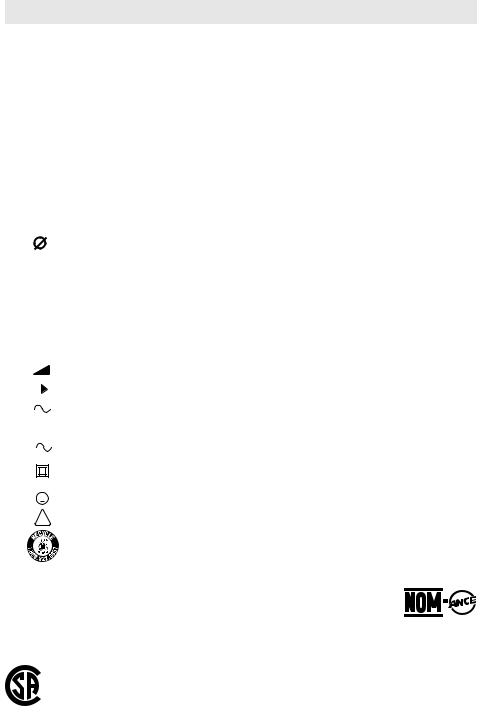
Symbols
IMPORTANT: Some of the following symbols may be used on your tool. Please study them and learn their meaning. Proper interpretation of these symbols will allow you to operate the tool better and safer.
Symbol |
Name |
Designation/Explanation |
|||||
|
V |
Volts |
Voltage (potential) |
||||
|
A |
Amperes |
Current |
||||
Hz |
Hertz |
Frequency (cycles per second) |
|||||
W |
Watt |
Power |
|||||
kg |
Kilograms |
Weight |
|||||
min |
Minutes |
Time |
|||||
|
s |
Seconds |
Time |
||||
|
|
|
|
|
|
Diameter |
Size of drill bits, grinding wheels, etc. |
n0 |
No load speed |
Rotational speed, at no load |
|||||
.../min |
Revolutions or reciprocation per minute |
Revolutions, strokes, surface speed, |
|||||
|
|
|
|
|
|
|
orbits etc. per minute |
0 |
|
|
|
Off position |
Zero speed, zero torque... |
||
1, 2, 3, ... |
Selector settings |
Speed, torque or position settings. |
|||||
I, II, III, |
|
Higher number means greater speed |
|||||
0 |
|
|
|
|
|
Infinitely variable selector with off |
Speed is increasing from 0 setting |
|
|
|
|
|
|
Arrow |
Action in the direction of arrow |
|
|
|
|
|
|
||
|
|
|
|
|
|
||
|
|
|
|
|
|
Alternating current |
Type or a characteristic of current |
|
|
|
|
|
|
Direct current |
Type or a characteristic of current |
|
|
|
|
|
|
||
|
|
|
|
|
|
||
|
|
|
|
|
|
Alternating or direct current |
Type or a characteristic of current |
|
|
|
|
|
|
||
|
|
|
|
|
|
Class II construction |
Designates Double Insulated |
|
|
|
|
|
|
||
|
|
|
|
|
|
|
Construction tools. |
|
|
|
|
|
|
|
|
|
|
|
|
|
|
Earthing terminal |
Grounding terminal |
|
|
|
|
|
|
||
|
|
|
|
|
|
Warning symbol |
Alerts user to warning messages |
|
|
|
|
|
|
||
|
|
|
|
|
|
||
|
|
|
|
|
|
Ni-Cad RBRC seal |
Designates Ni-Cad battery recycling |
|
|
|
|
|
|
|
program |
|
|
|
|
|
|
|
|
This symbol designates that this tool is listed by Underwriters Laboratories.
This symbol designates that this tool is listed by the Canadian Standards Association.
This symbol designates that this tool is listed to Canadian Standards by Underwriters Laboratories.
This symbol designates that this tool is listed by Underwriters Laboratories, and listed to Canadian Standards by Underwriters Laboratories.
This symbol designates that
this tool complies to NOM Mexican Standards.
-5-
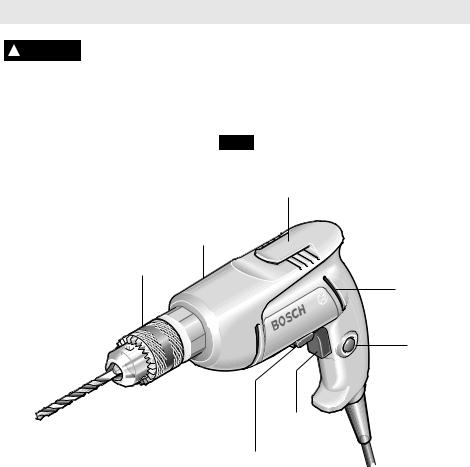
Functional Description and Specifications
! WARNING Disconnect the plug from the power source before making any assembly, adjustments or changing accessories. Such preventive safety
measures reduce the risk of starting the tool accidentally.
Drills
FIG. 1
HIP CLIP
MOTOR
HOUSING
CHUCK
AIR
VENTS
“LOCK-ON”
BUTTON
TRIGGER
REVERSING
SWITCH
BUTTON
|
|
|
MAXIMUM CAPACITIES |
|
||
Model |
Chuck Size |
Screw |
Mild |
Hard |
Hole |
Auger |
No. |
and type |
Sizes |
Steel |
Wood |
Saw |
Bit |
1004VSR |
3/8” Keyed |
#8 x 2-1/2” |
3/8” |
1” |
1-3/8” |
NR |
1005VSR |
3/8” Keyless |
#8 x 2-1/2” |
3/8” |
1” |
1-3/8” |
NR |
NR = Not recommended
ATTENTION: 3/8 inch drills are not recommended for running lag bolts
NOTE: For tool specifications refer to the nameplate on your tool.
-6-
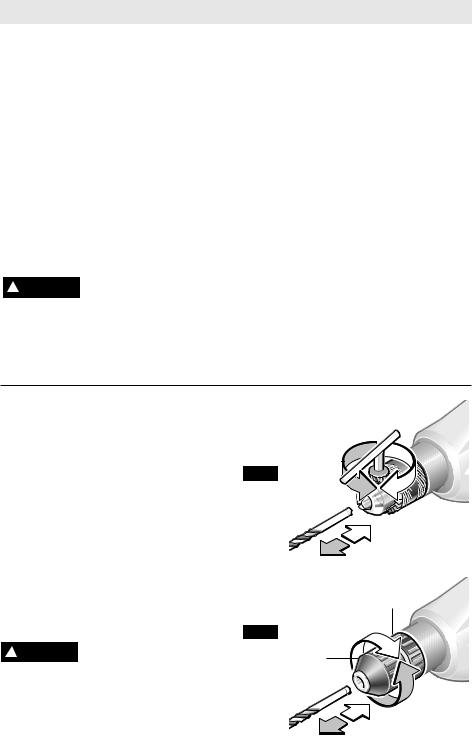
Operating Instructions
TRIGGER CONTROLLED VARIABLE SPEED
Your tool is equipped with a variable speed trigger switch. The tool speed can be controlled from minimum to maximum nameplate rated RPM by the pressure you apply to the trigger. Apply more pressure to increase the speed and release pressure to decrease speed (Fig. 1).
"LOCK-ON" BUTTON
Your tool is also equipped with a “Lock-ON” button located on the left side of the trigger handle that allows for operation at maximum RPM without holding the trigger (Fig. 1).
TO LOCK TRIGGER "ON": squeeze trigger, depress button and release trigger.
TO UNLOCK THE TRIGGER: squeeze trigger and release it without depressing the "LockON" button.
! WARNING If the “Lock-ON” button is continuously being depressed,
the trigger can not be released.
REVERSING SWITCH BUTTON
The reversing switch button is located above the trigger switch and is used to reverse rotation of the bit. For forward rotation, (with the chuck pointed away from you) move button to the far left. For reverse rotation move the button to the far right.
! CAUTION |
Do not change direction of |
|
rotation until the tool comes to |
|
a complete stop. Shifting during rotation of the chuck can cause damage to the tool.
HIP CLIP
Your tool is equipped with a hip clip that allows you to conveniently attach your drill to your belt, (Fig.1) This feature will allow you to have both hands free when climbing a ladder or positioning material to be fastened.
CHUCK KEY & STORAGE AREA
Keyed models are equipped with a chuck key that is conveniently located on the cord protector where it is always handy and unlikely to get lost or misplaced.
INSERTING BIT
For small bits, open jaws enough to insert the bit up to the flutes. For large bits, insert the bit as far as it will go. Center the bit as you close the jaws by hand. This positions the bit properly, giving maximum contact between the chuck jaws and the bit shank.
KEYED MODELS
To tighten chuck, insert key into each of the three key holes in succession and tighten firmly. The chuck can be released by using one hole only (Fig. 2).
KEYLESS MODELS
To tighten, hold the chuck collar firmly with one hand and securely tighten the chuck sleeve with the other hand (Fig. 3).
! WARNING To prevent friction burns, or possible hand injury, do not
loosen or tighten the chuck by using the power of the drill.
FIG. 2
FIG. 3
CHUCK SLEEVE
CHUCK COLLAR
-7-
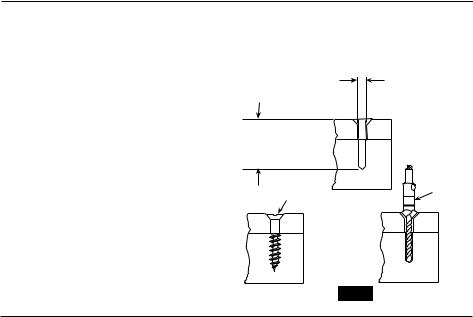
Operating Tips
You will extend the life of your bits and do neater work if you always put the bit in contact with the work before pulling the trigger. During the operation, hold the tool firmly and exert light, steady pressure. Too much pressure at low speed will stall the tool. Too little pressure will keep the bit from cutting and cause excess friction by sliding over the surface. This can be damaging to both tool and bit.
DRILLING WITH VARIABLE SPEED
The trigger controlled variable speed feature will eliminate the need for center punches in hard materials. The variable speed trigger
allows you to slowly increase RPM. By using a slow starting speed, you are able to keep the bit from “wandering”. You can increase the speed as the bit “bites” into the work by squeezing the trigger.
DRIVING WITH VARIABLE SPEED
Variable speed drills will double as a power screwdriver by using a screwdriver bit in the drill mode. The technique is to start slowly, increasing the speed as the screw runs down. Set the screw snugly by slowing to a stop. Prior to driving screws, pilot and clearance holes should be drilled.
FASTENING WITH SCREWS
The procedure shown in (Fig. 4) will enable you to fasten materials together with your hammer drill in the drill mode without stripping, splitting or separating the material.
First, clamp the pieces together and drill the first hole 2/3 the diameter of the screw. If the material is soft, drill only 2/3 the proper length. If it is hard, drill the entire length.
Second, unclamp the pieces and drill the second hole the same diameter as the screw shank in the first or top piece of wood.
Third, if flat head screw is used, countersink the hole to make the screw flush with the surface. Then, simply apply even pressure when driving the screw. The screw shank clearance hole in the first piece allows the screw head to pull the pieces tightly together.
The adjustable screw drill accessory will do all of these operations quickly and easily. Screw drills are available for screw sizes No. 6, 8, 10 and 12.
FASTENING
WITH SCREWS
1.Drill 2/3 diameter and 2/3 of screw length for soft materials, full length for hard materials.
Screw
Apply a slight even pressure when driving screws.
2. Drill same diameter as screw shank.
 3. Countersink same diameter as screw head.
3. Countersink same diameter as screw head.
Adjustable
Screw
Drill
FIG. 4
DRILL BITS
Always inspect drill bits for excessive wear. Use only bits that are sharp and in good condition.
TWIST BITS: Available with straight and reduced shanks for wood and light duty metal drilling. High speed bits cut faster and last longer on hard materials.
CARBIDE TIPPED BITS: Used for drilling stone, concrete, plaster, cement and other unusually hard nonmetals. Use continuous heavy feed pressure when employing carbide tip bits.
DRILLING WOOD
Be certain workpiece is clamped or anchored firmly. Always apply pressure in a straight line with the drill bit. Maintain enough pressure to keep the drill “biting”.
When drilling holes in wood, twist bits can be used. Twist bits may overheat unless pulled out frequently to clear chips from flutes.
Use a “back-up” block of wood for work that is likely to splinter, such as thin materials.
You will drill a cleaner hole if you ease up on the pressure just before the bit breaks through
-8-
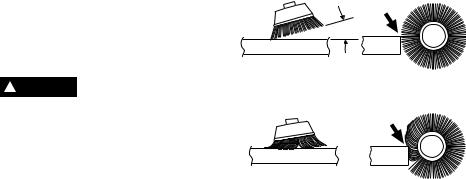
Operating Tips — cont.
the wood. Then complete the hole from the back side.
DRILLING METAL
There are two rules for drilling hard materials. First, the harder the material, the greater the pressure you need to apply to the tool. Second, the harder the material, the slower the speed. Here are a couple of tips for drilling in metal. Lubricate the tip of the bit occasionally with cutting oil except when drilling soft metals such as aluminum, copper or cast iron. If the hole to be drilled is fairly large, drill a smaller hole first, then enlarge to the required size, it’s often faster in the long run. Maintain enough pressure to assure that the bit does not just spin in the hole. This will dull the bit and greatly shorten its life.
DRILLING MASONRY
Soft materials such as brick are relatively easy to drill. Concrete however, will require much more pressure to keep the bit from spinning. Be sure to use carbide tip bits for all masonry work.
! WARNING Before using an accessory, be certain that its maximum
safe operating speed is not exceeded by the nameplate speed of the tool. Do not exceed the recommended wheel diameter.
SANDING AND POLISHING
You will find the “Lock-ON” button feature a convenience for the continuous operation required for rough sanding. Fine sanding and polishing require “touch”. Select the most efficient speed.
When using polishing bonnets, alway be sure the excess string that secures the bonnet is tucked well within the bonnet during operation.
WIRE BRUSHES
Work with brushes requires high speeds. Use of the “Lock-ON” button feature will provide a much easier operation.
BRUSHING PRESSURE
1.Remember, the tips of a wire brush do the work. Operate the brush with the lightest pressure so only the tips of the wire come in contact with the work.
2.If heavier pressures are used, the wires will be overstressed, resulting in a wiping action; and if this is continued, the life of the brush will be shortened due to wire fatigue.
3.Apply the brush to the work in such a way that as much of the brush face as possible is in full contact with the work. Applying the side or edge of the brush to the work will result in wire breakage and shortened brush life.
CORRECT: Wire tips doing the work.
15
INCORRECT: Excessive pressure can cause wire breakage.
RUNNING NUTS AND BOLTS
Variable speed control must be used with caution for driving nuts and bolts with socket set attachments. The technique is to start slowly, increasing speed as the nut or bolt runs down. Set the nut or bolt snugly by slowing the drill to a stop. If this procedure is not followed, the tool will have a tendency to torque or twist in your hands when the nut or bolt seats.
-9-

Maintenance
Service
! WARNING Preventive maintenance performed by unauthorized personnel may result in misplacing
of internal wires and components which could cause serious hazard. We recommend that all tool service be performed by a Bosch Factory Service Center or Authorized Bosch Service Station.
TOOL LUBRICATION
Your Bosch tool has been properly lubricated and is ready to use. It is recommended that tools with gears be regreased with a special gear lubricant at every brush change.
CARBON BRUSHES
The brushes and commutator in your tool have been engineered for many hours of dependable service. To maintain peak efficiency of the motor, we recommend every two to six months the brushes be examined. Only genuine Bosch replacement brushes specially designed for your tool should be used.
BEARINGS
After about 300-400 hours of operation, or at every second brush change, the bearings
should be replaced at Bosch Factory Service Center or Authorized Bosch Service Station. Bearings which become noisy (due to heavy load or very abrasive material cutting) should be replaced at once to avoid overheating or motor failure.
Cleaning
! WARNING To avoid accidents always disconnect the tool from
the power supply before cleaning or performing any maintenance. The tool may be cleaned most effectively with compressed dry air. Always wear safety goggles when cleaning tools with compressed air.
Ventilation openings and switch levers must be kept clean and free of foreign matter. Do not attempt to clean by inserting pointed objects through openings.
! CAUTION Certain cleaning agents and solvents damage
plastic parts. Some of these are: gasoline, carbon tetrachloride, chlorinated cleaning solvents, ammonia and household detergents that contain ammonia.
Accessories
! WARNING If an extension cord is necessary, a cord with
adequate size conductors that is capable of carrying the current necessary for your tool must be used. This will prevent excessive voltage drop, loss of power or overheating. Grounded tools must use 3-wire extension cords that have 3-prong plugs and receptacles.
NOTE: The smaller the gauge number, the heavier the cord.
RECOMMENDED SIZES OF EXTENSION CORDS 120 VOLT ALTERNATING CURRENT TOOLS
Tool’s |
Cord Size in A.W.G. |
Wire Sizes in mm2 |
|||||||
|
|
|
|
|
|
|
|
||
Ampere |
|
|
|
|
|
|
|
|
|
Cord Length in Feet |
Cord Length in Meters |
||||||||
Rating |
|||||||||
25 |
50 |
100 |
150 |
15 |
30 |
60 |
120 |
||
|
|||||||||
3-6 |
|
|
|
|
|
|
|
|
|
18 |
16 |
16 |
14 |
0.75 |
0.75 |
1.5 |
2.5 |
||
6-8 |
18 |
16 |
14 |
12 |
0.75 |
1.0 |
2.5 |
4.0 |
|
8-10 |
18 |
16 |
14 |
12 |
0.75 |
1.0 |
2.5 |
4.0 |
|
10-12 |
16 |
16 |
14 |
12 |
1.0 |
2.5 |
4.0 |
— |
|
12-16 |
14 |
12 |
— |
— |
— |
— |
— |
— |
|
|
|
|
|
|
|
|
|
|
|
-10-
